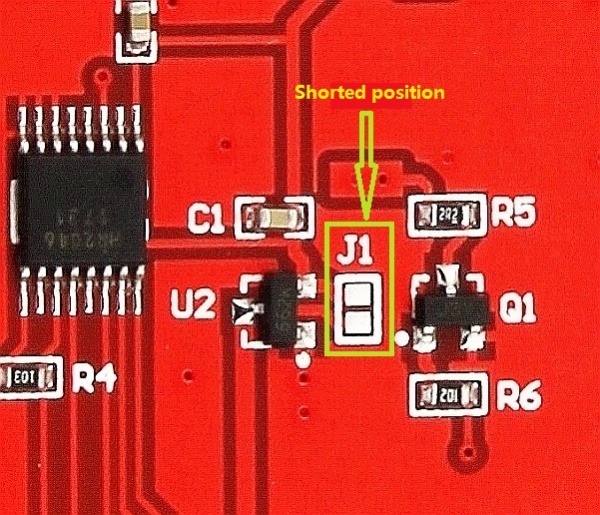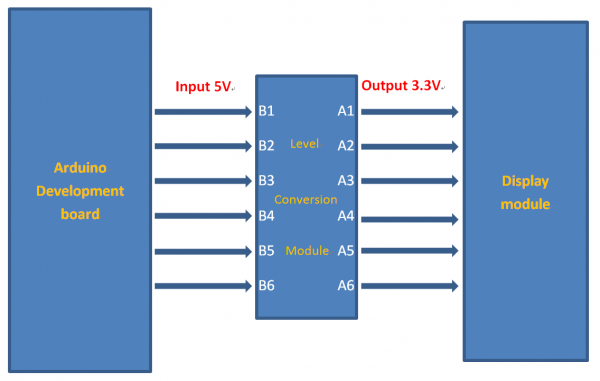Difference between revisions of "Run Arduino Demo in spi model"
(→External Level Conversion Module Method) |
|||
| (5 intermediate revisions by the same user not shown) | |||
| Line 1: | Line 1: | ||
==<font color="blue">Overview</font> == | ==<font color="blue">Overview</font> == | ||
| − | :When we directly connected the SPI display module without the on-board level conversion module to the Arduino, | + | :When we directly connected the SPI display module without the on-board level conversion module to the Arduino, |
| − | This is because the SPI module's pin can only input a 3.3V high level, while the Arduino output has a high level of 5V. To run successfully, there are two | + | we found that it could not run at all.This is because the SPI module's pin can only input a 3.3V high level, |
| + | |||
| + | while the Arduino output has a high level of 5V. | ||
| + | |||
| + | To run successfully, there are two Method: short circuit method and external level conversion module method. | ||
| − | + | :The short-circuit method has the advantages of simple operation, short wiring, and no need for external devices. | |
| − | + | The disadvantage is that the module generates a large amount of heat during operation. | |
Will affect the life of the module. | Will affect the life of the module. | ||
| − | :The external level conversion module method is a normal operation, and the advantage is that the module generates less heat and runs stably during operation, and the disadvantage is that the operation is slightly complicated. | + | :The external level conversion module method is a normal operation, and the advantage is that the module generates |
| + | |||
| + | less heat and runs stably during operation, and the disadvantage is that the operation is slightly complicated. | ||
(An external level shifting module is required) to increase the cost (additional level conversion module is required). | (An external level shifting module is required) to increase the cost (additional level conversion module is required). | ||
| Line 18: | Line 24: | ||
==<font color="blue">Short-Circuit Method</font> == | ==<font color="blue">Short-Circuit Method</font> == | ||
| − | :The short-circuit method is to short the '''J1''' component position (shown below) with solder on the back of the module. | + | :The short-circuit method is to short the '''J1''' component position (shown below) with solder on the back of the module. |
| − | The pin must be connected to a 5V power supply (not connected to 3.3V). | + | After shorting, the runtime module VCC The pin must be connected to a 5V power supply (not connected to 3.3V). |
| − | [[File:MSP2402- | + | [[File:MSP2402-011.jpg|600px]] |
==<font color="blue">External Level Conversion Module Method</font> == | ==<font color="blue">External Level Conversion Module Method</font> == | ||
| − | :The so-called external level conversion module method is to connect the Arduino and the display module through an external level conversion module, so that | + | :The so-called external level conversion module method is to connect the Arduino and the display module |
| + | |||
| + | through an external level conversion module, so that The 5V high level of the Arduino output is converted | ||
| − | + | to 3.3V by the level conversion module and then input to the display module. As shown below: | |
| − | [[File:MSP2402- | + | [[File:MSP2402-012.png|600px]] |
Latest revision as of 16:32, 30 November 2018
Overview
- When we directly connected the SPI display module without the on-board level conversion module to the Arduino,
we found that it could not run at all.This is because the SPI module's pin can only input a 3.3V high level,
while the Arduino output has a high level of 5V.
To run successfully, there are two Method: short circuit method and external level conversion module method.
- The short-circuit method has the advantages of simple operation, short wiring, and no need for external devices.
The disadvantage is that the module generates a large amount of heat during operation.
Will affect the life of the module.
- The external level conversion module method is a normal operation, and the advantage is that the module generates
less heat and runs stably during operation, and the disadvantage is that the operation is slightly complicated.
(An external level shifting module is required) to increase the cost (additional level conversion module is required).
- In summary, it is recommended to use the external level shifting module method.
Short-Circuit Method
- The short-circuit method is to short the J1 component position (shown below) with solder on the back of the module.
After shorting, the runtime module VCC The pin must be connected to a 5V power supply (not connected to 3.3V).
External Level Conversion Module Method
- The so-called external level conversion module method is to connect the Arduino and the display module
through an external level conversion module, so that The 5V high level of the Arduino output is converted
to 3.3V by the level conversion module and then input to the display module. As shown below:

